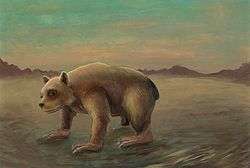Chapalmalania
| Chapalmalania | |
|---|---|
 | |
| Scientific classification | |
| Kingdom: | Animalia |
| Phylum: | Chordata |
| Class: | Mammalia |
| Order: | Carnivora |
| Family: | Procyonidae |
| Genus: | †Chapalmalania Ameghino, 1908 |
| Species | |
| |
Chapalmalania is an extinct genus of procyonid from the Pliocene (Chapadmalalan to Uquian) of Argentina and Colombia (Ware Formation, Cocinetas Basin, La Guajira),[1][2] South America, which lived from 3.6 to 3.0 Ma.[1]
Description
Though related to raccoons and coatis, Chapalmalania was a large creature, reaching about 1.5 metres (4.9 ft) in body length, with a short tail. It probably resembled the giant panda. Due to its size, its remains were initially identified as those of a bear. It evolved from the "dog-coati" Cyonasua, which probably island-hopped from Central America during the late Miocene (7.5 million years ago), as perhaps the earliest southward mammalian migrants of the Great American Interchange. When the Isthmus of Panama rose from the sea to allow further invasions by other North American species, Chapalmalania was unable to compete and its lineage became extinct.[3]
References
- 1 2 Chapalmalania at Fossilworks.org
- ↑ Amson et al., 2016, p.15
- ↑ Palmer, D., ed. (1999). The Marshall Illustrated Encyclopedia of Dinosaurs and Prehistoric Animals. London: Marshall Editions. p. 215. ISBN 1-84028-152-9.
Bibliography
- Amson, Eli; Juan D. Carrillo, and Carlos Jaramillo. 2016. Neogene sloth assemblages (Mammalia, Pilosa) of the Cocinetas Basin (La Guajira, Colombia): Implications for the Great American Biotic Interchange. Palaeontology _. 1-20. Accessed 2017-03-31.
Further reading
- Barry Cox, Colin Harrison, R.J.G. Savage, and Brian Gardiner. (1999): The Simon & Schuster Encyclopedia of Dinosaurs and Prehistoric Creatures: A Visual Who's Who of Prehistoric Life. Simon & Schuster.
- David Norman. (2001): The Big Book Of Dinosaurs. page 13, Walcome books.